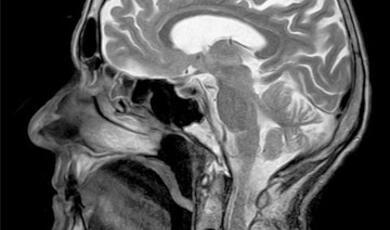Eating Disorders
Share
- Details
- Text
- Audio
- Downloads
- Extra Reading
A lecture to investigate the problems of eating disorders such as bulimia and anorexia, by Professor Janet Treasure of the Institute of Psychiatry at King's College London. This lecture includes a personal account of suffering from an eating disorder by Melissa Wolfe.
For help and information about eating disorders, please visit these websites:
www.eatingresearch.com
www.findingmelissa.co.uk
This is part of a special series of lectures in collaboration with the Institute of Psychiatry.
Download Text
Eating Disorders
Janet Treasure and Melissa Wolfe
Janet Treasure
History shows a variety of different various stages and framing of eating disorders. In about the 1600s, eating disorders were classified as aesthetic, religious types of behaviour. There is a book there about Rudolph Bell, writing about several female saints that seemed to have a lot of the behaviours that we now recognise as eating disorder.
In the 18th century there is a change whereby where science became interested in this area and people then thought 'How can people not eat?' People who suffered from eating disorders were then regarded as breaking the laws of nature and as freaks. So we find documents from the time of people like the Derbyshire Damsel, who you could to go and see and she was a young girl who seemed not to need to eat. There are several of these fasting girls around at that time, and it is probable that they did have an eating disorder, but then got notoriety because of this.
Then, in 1860, a physician at Guy's Hospital in London began to take a specific interest in eating disorders. Sir William Gull was in fact even the Queen's physician, and it was he who, after several iterations, saw that there was something wrong with their appetite in these patients, and so gave it the name 'anorexia'. Initially, he was going to call it 'hysterical' because it was mainly in women, but then he decided that it was nothing to do with the uterus but definitely to do with the brain, and so that was why he called it 'anorexia nervosa'. At the same time as Gull, in France Charles Lasègue also writing about the disease, and so there is something of a debate in medical history as to who was first to discover the condition.
It is only in this century that it has been seen as a psychiatric disorder. In fact, when I qualified in medicine, on the wards that I worked, we had cases of eating disorder on a general medical ward, so it was regarded more as a medical disorder than a psychiatric disorder.
From this little overview of the history, you can see how the way that society understands behaviour can alter whether it is seen as an illness or not, and, if it is an illness, what sort of illness.
The discovery of bulimia as a distinct form of eating disorder was made by Gerald Russell, who was my boss at King's College London. In 1979 he was the first person to name and describe bulimia nervosa, characterised by occurring with people who had anorexia, but who switch from restricting their intake to having episodic overeating which they tried to compensate for.
Since his description of that, there have been a variety of sub-types of eating disorder: Restricting AN (anorexia nervosa), binge-purging AN, purging disorder, purging BN, non-purging BN, binge-eating and simple obesity. So you can see that we are now stretching from very thin people with restricting up into obesity, and recognising that a proportion of people with obesity have an eating disorder because they overeat and cannot control their eating. In fact, people such as Nora Volkow, who is in charge of the NIH, the American research institute on addictions, consider that some forms of overeating are just like additions.
From this you can see how the spectrum has changed from these early beginnings and now there are a lot of different disorders. At the moment, the diagnostic system is in a bit of a flux, and where we cut all these different types of eating disorder is a bit uncertain.
Anorexia was known of a long time ago but it is not the commonest eating disorder now. In fact, it is the least common. In a lifetime of women, about 0.5-2% have anorexia nervosa, whereas with bulimia nervosa it can be 2-4%, but the much bigger group are those who do not fit either of those. They are perhaps not thin enough to be anorexic, they perhaps do not overeat enough to be called a binge, but their eating is very chaotic, so they are called 'eating order not otherwise specified', so their eating problem interferes with their general health, but does not fit these categories. The levels of that seem to be increasing, from 2 to 10%.
From a series of surveys in America, corroborated by the findings done in Europe and Australia, there has been a massive rise in the risk of eating disorders ever since the generation born in 1950. Something has been happening from people born since 1950 in that each cohort has more eating disorders. Also, when we look at the levels and try to see where and when these occur, bulimia nervosa itself seems to occur more in towns, a 9:1 ratio, and also there is evidence that bulimia happens more in westernised cultures. These are interesting findings, because they help us understand why these disorders develop.
Data from GP practices in the UK show that, from 1988 onwards, there is not much change in incidences of anorexia: every year there is roughly the same number of cases. But the levels of bulimia nervosa increased in the 1990's, to peak in 1996 at more than double its 1989 level, but the levels seem to be settling somewhat now.
These findings make us ask questions: what has caused this sudden change in the form of eating disorders and why so many more in people born since 1950? Why particularly in the West, and is there any understanding of why urban rather than rural?
A colleague in America, Anne Becker, has done a lovely research project, in that she is trained in Anthropology and she went to Fiji when they were starting to have the television introduced into their culture. It is quite interesting because the general preference for shape tended to be on the plumper side in this area of the world, and what she found was, after the introduction of Western values and media images, there was an increase in weight concern and disturbed eating in the female population, so perhaps explaining what has been happening in our own culture since 1950. It suggests a change in the idealisation of the thinness, the 'size zero of culture', and it shows that this seems to have effects in other areas of the world.
We now think that probably there are these three separate, but related, reasons that perhaps can explain this epidemiology of getting more binge eating disorders:
1) Size 0 culture & promotion of dieting;
2) Vomiting/purging as a method of weight loss;
3) Easy access to high palatable food disembedded from social eating.
We now the size-zero culture and the promotion of dieting, such that it is rare for a young woman not to have gone on a diet in her life. The second aspect is the promulgation of the idea that vomiting might be a very good weight control method, and that seems to be something that increases the risk of an eating disorder. But, not only have we this culture of dieting, but we have got a tension in that we have got very highly palatable foods that are easily accessible and can be taken outside normal social eating, so our eating patterns have all been changed and it is easy to snack on things. I am going to be talking about this later to get some understanding of how this fits with the brain.
But I have already explained that anorexia has a long history, so this change in culture cannot explain anorexia as it comes after its discovery, so there must be other factors. So this tension between so much high palatable food and dieting probably relates to bulimia, but probably is not as relevant for anorexia. So I am going to turn now to Melissa, who is going to talk about her story, so that you can get a clinical experience from somebody who knows all about it.
Melissa Wolfe
Telling my story has always been something that I have been totally against, and it is therefore with a touch of irony that I am about to do just that.
I developed anorexia at the age of twelve, and soon picked up bulimic behaviours, firstly, just to avoid food, and then as part of a binging and purging cycle. My experiences were severe and I had a number of hospital admissions in child and then adult EDUs, and acute psychiatric wards. I was severely underweight for much of this time and completely trapped in a pattern of starvation and chronic binging.
On 25th July last year, I finally managed to stop throwing up, as my frustration with being trapped in such an isolating and violent cycle reached a breaking point, and the physical consequences of my illness were becoming increasingly evident.
Six months ago, and following another uncomfortably close call, I realised that gaining weight was also a good thing, and that the only way that I would be able to extract myself from the illness was to externalise my experiences, firstly, through a website, and then through talking. As I have undertaken this activity, I have become increasingly aware of how difficult people find understanding eating disorders and just how many people are going through the same struggles that I had considered totally unique.
For many people today, anorexia is heavily associated with the size zero culture and the influence of the media, and it is therefore through this theme that I will start to explore my personal experiences and reflect on the part the media played in my illness.
I am going to structure my talk around my journey from becoming ill through to the process of recovery. I will try and explore how I was engaged with or responded to the media and size zero at each stage, and also touch on the other factors that were foremost in causing and then maintaining my illness.
I also want to acknowledge that eating disorders appear to be highly subjective experiences and very dependent on how someone reads and interacts with the world. My take on size zero may be wholly different from the next person's, so I am afraid that I cannot reveal the secrets or provide any definitive insights or answers, but hopefully I can start opening up an understanding of these conditions.
I am going to begin by considering what was going on in 1993, both socially and personally for me, and then start looking at when and how the media informed my experiences.
Things have changed very quickly in the past decade, and, in 1993, eating disorders were not as common as they are now. When I was twelve a computer was more like a typewriter, the internet was in its infancy, and TV did not have as many channels. We were not as grown-up as children today. I used to read the cartoon section in my parents' paper as opposed to Teen Vogue, and clothes sizes were conceived of more in terms of age. Size zero was unheard of, at least for my age group.
Up until the age of twelve, my childhood was unremarkable, and my relationship with food was normal. I was an average weight, did not give what I ate that much thought, and I did not go through any traumatic events. I was, however, a little insecure, a bit too worried about what people thought of me, and I was starting to become aware, as twelve years olds do, of how I looked and how other people looked. With hindsight, I also demonstrated some of the characteristics that people seem to link to eating disorders: I was high-achieving, a bit over-sensitive, competitive, and had a tendency to think about things far too much.
At the time, I had just started secondary school, was heavily involved in performing on the violin, and was going through a difficult teenage phase. Food first entered into the equation when I had a brace fitted and was unable to eat certain things. It also corresponded with a fad of vegetarianism at school and the beginnings of an association in my mind between food and discipline. For some reason, I started linking eating to being greedy or bad, and not eating as being a demonstration of being in control or good. Hence, in my attempt to be good, I cut out a number of foods for Lent in 1993, and by Easter, I was too scared to eat them again. At this point, I was diagnosed with anorexia. I had not heard of the illness and, at this stage, I had not started getting entrenched in weight and my appearance.
Over the years, and particularly in the early stages, I spent a very long time trying to work out what had caused my eating disorder. Working with a variety of therapists, I felt like I had exhausted all the options, and was convinced that something had happened to me that I had either forgotten or blocked out. It has only been through really breaking down my experience that I realised that my eating disorder was not caused by anything specific or clearly identifiable. It was, instead, caused by a combination of: how I was feeling - insecurity and lack of self-belief; personality traits - perfectionism, a tendency towards addictive behaviours; events - the transition into secondary school; social pressures; vegetarianism; and girls' school cliques, and later, the wider influence of the media.
My illness seemed to coincide with an increasing media interest in anorexia, particularly in relation to young people, and it was during my first in-patient treatment that I began to notice this trend. As film crews and photographers visited the unit I was on, anorexia began to feel quite glamorous, and the idea that it was a positive, rather than a negative, was vaunted. In parallel to this, anorexia was portrayed to the wider world as a disorder that was all about body image and vanity, and linked to models and fashion.
Therefore, by the time I left treatment and returned to school, two things had happened: firstly, I had started to feel like anorexia made me special; and secondly, as anorexia featured in the media more noticeably, other people began making assumptions about why I was ill based on what they were reading. I was often treated, therefore, as though my behaviour was a sign of vanity or a misplaced teenage fad based on obsession with appearance, and this trend was set to continue, particularly when the phrase 'size zero' emerged and as eating disorders became more prevalent.
So, to summarise, by the end of 1993, I had developed a full-blown eating disorder with little help from the media and no consideration of size zero. My eating disorder had been a result of a range of emotional, psychological, and social experiences, and thinness had emerged as a way of feeling better about myself and avoiding any emotional discomfort. It was at this point that the media started to contribute to my illness: firstly, through confusing the cause, both for myself and for others; and, secondly, by re-affirming my belief that being thin was an asset.
My eating disorder was active for 17 years. Despite numerous interventions and some pretty scary experiences, I was too trapped and scared to change, and I could not quite see recovery as a positive move. I now want to look at why my eating disorder lasted so long and whether the media helped keep it going.
There were lots of things that kept me trapped in an eating disorder. Some were linked into the physical addition, others to my personality, and some to external influences, like the media. In the early stages of my illness, I fought tooth and nail, firstly, against the diagnosis, and then against the proposed treatment: eating and gaining weight. The terror invoked by either of these activities was so great that I went to extreme lengths to actively avoid them, and used every argument I could think of to challenge recovery and justify my illness, both to myself and others. Size zero offered one such justification.
When people expressed concern about my appearance or weight loss, their argument was far less convincing because the rest of the world, or so it seemed, advocated thinness. Images of super-skinny models confused the line between health and illness, not only helping me to deny the problem, but also feeding straight into the characteristics and behaviours that the anorexia was already using.
For me, my appearance only started to become really important because I was feeling so bad about who I was as a person. The sense of achievement I gained from losing weight started to reduce these feelings and made me feel as though I was more in control, and then, an element of competitiveness, or just total insecurity, kicked in: if being thin was the goal, then any examples of people who were thinner than I was were evidence of failure and a reinforcement of my own inadequacies. So, thin super-models gave me an external point of reference and, whilst it was easy to get hooked into focusing on being thin, I can see, with hindsight, that it was really a distraction from what was going on inside. The danger of overemphasising the media's influence is that all the things that are really going on can be hidden, both to the outsider and to the sufferer.
My eating disorder had really been about taking control and being what I considered 'good'. Being thin was the consequence, and liking this feeling kept me trapped, but, in many ways, this was just a big distraction from the real causes of my eating disorder. I think that I sensed this at the time, as I was increasingly frustrated by people's mis-assumptions about my behaviour. However, I also concurred with the emphasis on appearance, by becoming increasingly fixated on the idea of thinness. As the real causes and motivations got a bit lost, I began to get more wrapped up in weight and size and identifying myself through an illness, playing into the idea that my eating disorder was all about appearance. It took me about ten years to realise that I had got sidetracked by the idea of being thin.
Just to finish, I would like to give a brief overview of how I started moving towards recovery, and then to consider where the media impacted on this process.
Up until 2007, my eating disorder was the most important thing in my world. It had infiltrated every aspect of my life and dictated my routine every single day. This meant that I approached recovery with fear and ambivalence. An eating disordered life was all I could remember, and the thought of change was too terrifying to consider, particularly following numerous painful, and failed, attempts at treatment. Alongside this fear, I was isolated to the point of desperation, and totally frustrated by both the futility of my existence and my inability to alter this. Furthermore, I was beginning to realise that size zero came at a cost.
After years of illness, I had few friends and few normal social interactions. Whilst I was in treatment, this had been bearable, but living alone, and finally beginning to see what was going on in the rest of the world, without being included in it, was an incredibly painful experience.
The reality of size zero and living with an eating disorder was far less glamorous than the magazines would have you believe. Losing my teeth, not having enough energy to do things, constantly being tired and cold, were big catalysts in my recovery, and, in conjunction with understanding the emotional context behind my illness, helped me to start viewing being thin as a negative rather than a positive. Unfortunately, the media did not seem to agree.
By the time I was finally able to start moving towards health, I was a lot stronger in my mind and more able to switch off to the influences of the media. My experience could challenge the idea that size zero was a positive, and the impact that my eating disorder had had on me emotionally, socially, and physically, contradicted the impression that thinness was an asset. However, it was still difficult to switch off completely, and it often felt like I was swimming against the tide, particularly as I started the difficult process of gaining weight.
For a start, weight loss tips and advice are present on a daily basis through a range of mediums, from switching on the computer to prime-time viewing. The message that we should all be watching our weight is hard to avoid. And then, size zero now appears relatively healthy in light of other images used by the media, and I had to consciously seek role models from other, healthier, contexts in order to reassure myself about weight gain, particularly with the emergence of air-brushing and the falsifying of appearances. Whilst I think that I have moved far enough away from my illness now to have a little resilience to Photoshopped photography, had these images been around in the earlier phases of my illness, they would have been lethal ammunition for my disorder, and are probably equally dangerous to young people today. So, in my recovery, the media was most noticeable by its absence and in relation to my increasing frustration at the clouded and dangerous messages that were being given.
To summarise, my eating disorder was not caused by the media, but by a combination of my characteristics, how I was feeling, and what was going on in my life. I managed my feelings and insecurities through controlling my weight and food, and being thin was the consequence of what was going on internally and not, at first, an objective in itself. Size zero in the media helped maintain my eating disorder by reinforcing the idea that thinness would make me special, and by continuing to divert the focus from the cause to the consequence or symptom. However, the physical addition, an obsessive nature, and my failure to address these issues that had started my illness featured significantly in its longevity.
My recovery was driven by my frustration with the real experience of an eating discovery - isolation and illness - and the recognition that I had been ignoring the real causes and emotions behind my illness. It was a slow and difficult process, in which the media offered little positive contributions, as, in many ways, I was actively contradicting their message.
Self-esteem, or a lack of this, was the overriding connection at each stage of my illness. It made me vulnerable to the eating disorder, in the first instance, and then to the media in later stages. Feeling inadequate led me to fixate on external qualities, and a lack of respect for myself enabled me to continue abusing my body. It has been through really exploring and then developing my sense of self that I have been able to move away from my eating disorder and find qualities that are far more important than being size zero.
Thank you.
Janet Treasure
If we want to understand the different causes, Melissa has indicated one cause that is often considered to be very important, whereas we know there is a matrix of other causes. It has been helpful to understand these in terms of trying to be more specific and targeting our treatment.
We should really see the development of an eating disorder as a complex thing, with a variety of predisposing factors one could see as bullets that are effectively set off right at the beginning of your life - the genes, the environment as it plays a role on our biology throughout the life course. Therefore, stress during pregnancy or birth seems to increase the risk, living in an environment where values about shape and eating are important, if there has been teasing or bullying about weight or shape, and an atmosphere of competition and comparison and high expectations - all of these types of things play a rople. And then, the individual themselves brings to it, perhaps because of genes, perhaps because of these learning experiences, a very anxious temperament, low self-esteem as Melissa talked about, and somebody who likes to have structure and plans and rules. So we know that an increase in life events and stress during pregnancy does seem to increase the risk of getting an eating disorder later, and perhaps even the hormonal environment, some studies suggest, might be relevant.
The teasing and critical comments about weight and shape can be in many forms. Often those within the home are particularly hurtful and potent, but it might come from teachers, sports coaches, or a wide variety of individuals, and of course peers, who make weight and shape very salient.
Fathers also seem to be particularly important for eating disorders. Often, in all psychiatric disorders, mothers have been mentioned, whereas fathers do play a role. In some of the longitudinal studies, there is clear evidence that the relationship with the father has an effect. The stronger the relationship with the father is, the greater the protection against possible eating disorders; whereas, if the relationship is weak, people are more at risk of getting an eating disorder. If fathers value the culture of thinness, they can transmit to their daughters very potently, and if they tease their daughters about weight and shape, it encourages brothers and other siblings to do it, and that is particularly toxic.
So we have this developing biological matrix at the beginning, and we have the environment that has an influence over the developing life course. We have got those cultural factors, the media, which Melissa talked about, but then we have these specific events during the environment, and they interact with the biological matrix of genes and lead, developmentally and learning, to these various personal attributes, such as stress sensitivity and anxiety.
Then we have the triggers, and eating disorders tend to be triggered at a very critical period, in puberty. Therefore the period from 12 to 18 is the highest risk. There are a variety of things that form the trigger. Often the commonest is a diet, a weight loss, but there might be other reasons for having oscillations in food intake or energy expenditure, perhaps there might be operations on the jaw or high levels of exercise. Chronic stress, a negative effect seen to be related, and being in an environment where weight and shape values are important.
But, perhaps, rather than focussing on understanding these risks and triggers or the interaction between the environment, once you have got an eating disorder, as Melissa said, you can get factors that keep the illness going, and that perhaps explains why, in Melissa's case, it took over almost twenty years of her young developing life. The fact that eating disorders often have a very prolonged course is something that we should also very much pay attention to.
What we understand is that there can be some positive aspects of getting an eating disorder. It might seem rather strange to think that, but often, at the beginning, people get praised for losing weight and being thin in our culture, and sometimes, inadvertently, the reaction of the family and other people may be to praise the diligence and the application that these people show.
Then you get negative aspects of the illness that make recovery difficult. In particular, the brain itself is a very sensitive organ to nutrition and so the symptom itself deprives the brain of nutrition and effectively impairs the functioning of this organ that you importantly need to recover. You incur damage to other parts of the body and, as Melissa poignantly talked about, the damage to relationships and social isolation, and all of these things are what you need to help you recover from an illness like anorexia.
We are very interested, in all forms of psychiatric disorder, on the factors that keep an illness going. We perhaps are never going to be able to impact on the genes and all these various small environmental factors that shape a development, whereas we know that the factors that keep it going are there in our clinic and are currently active. So, most effective forms of psychotherapy that we use these days - cognitive behavioural therapy, motivational interviewing therapy, family work - tend to focus on factors that keep it going.
I have already alluded to the damage to the brain that this disorder can cause. We have to remember that the brain itself is a very hungry organ - perhaps, weight per weight, it requires more calories than any other body organ, and it needs this because it is constantly active, and we now know that the brain is a very plastic organ and so is growing and changing in response to environmental events, it forms new connections, new parts of the brain, and so, and these new synapses and connections require a degree of running cost.
It is important to realise that brain development goes on from conception, right through a very active stage with a lot of things happening in adolescence and even to adulthood. Anorexia tends to develop at a very critical phase of brain development, when we are pruning synapses and long connections are being formed. Therefore, whether this puts people at risk, is one possibility, but there is probably no doubt that the illness itself impacts on this process and stops it proceeding.
We know that starvation and weight loss impairs on complex brain tasks, especially those in the outer part of the brain, the neocortex. So, social cognition, how we understand other people, becomes impaired, and we have found this in eating disorders. Emotional recognition and regulation become impaired. The ability to be flexible, the ability to step back and see the bigger picture, to make plans and make good decisions, all of these are malfunctioning in people with anorexia nervosa, and are probably in most cases secondary to the nutritional problems in the brain.
This establishes a vicious circle. Poor nutrition impairs the complicated cascade of brain function that allows us to react to other people, to understand their non-verbal and verbal comments, to get attuned with them, and to be able to have successful relationships. People have dis-regulated emotion - with this disorder they have temper tantrums rather like a five year old. They are not very good at reading emotions in other people's eyes. They do not get the cues, and they do not attune well to other people. They appear to be rather frozen. They do not have facial expressions, and they seem to turn away when sad things are discussed. That worsens problems because people are less intimate and the quality of relationship goes down, and then they become lonely and isolated. With anorexia, their only friend and their only value, as Melissa said, was their eating disorder itself, and this is one of the really toxic aspects of the disorder.
Not only does it impact in that way, but the emotional system gets very upset, and not only the person with the eating disorder, but close others. People close to the sufferer get very anxious, but they also get frustrated because it is so worrying to see somebody looking as though they are going to die, a skeleton around you all the time, not eating with you, but it seems so frustrating. 'Why just you don't eat?!' you might want to say, 'it's so simple to eat! Why can't you do that?! That would solve your problems!' In this way, it is terribly frustrating to be close to someone with an eating disorder. Because of this it is very common for family members to either be anxious and overprotect or to get critical, and the person with the eating disorder mirrors these emotions but cannot regulate them, and these sort of anxieties and frustrations just help to keep the eating disorder going.
We also see an effect on the reward system of the brain. These get very disrupted by intermittent oscillations of food intake, especially in the context of starvation. A lot of work has been trying to understand the biological aspects of eating disorders, and work on rats has found that, if you starve rats and you just give them very high palatable food - biscuits - on a Monday, a Wednesday, and a Friday but not all the time, and if you stress them, then they start to overeat and show binge eating. Not only that, but these animals look addicted to food, and they also show addictive responses to substances, so amphetamines, alcohol, etc. So it is as if an addicted brain can develop if you have these setting conditions.
But let us turn to the human condition, to explain what has been happening since the 1950s. We have been undergoing a promotion of under-nutrition, trying to encourage people to be on diets. The vomiting we have talked about has been spread around as a good way of controlling your weight. Because people on a diet are so exposed to high palatable foods, they often have a very on-off, feasting-fasting of these high palatable foods. So you can see how this condition can then produce this addicted-like changes in the brain.
So, where are we? We have talked about the things that keep it going, but what about prevention? We are doing work to look at the offspring of people with eating disorders, to see if we can intervene early to stop these disorders passing on, and also, there has been prevention work looking at whether we can change people. So we are trying to see if we can identify people with high weight and shape concerns and do interventions there. The final element we need to work on is the image of weight as portrayed in the fashion industry and elsewhere. There is beginning to be a great concern and awareness in the industry about giving positive and sustainable examples of the body. So we often see corrective features about normal body shape in fashion and style magazines these days, and it is becoming much more rare to see 'Size Zero' models on catwalks. So people are trying to change some of these risks and maintaining factors.
To conclude, I hope I have shown you that a spectrum of eating disorders now exist, and what we have is this rather new pattern of eating disorders, where overeating occurs, and this is particularly in cohorts born after 1950. We have a variety of effects of these symptoms that affect our cognition, emotion, physical factors, work. It can be very difficult to overcome these problems, as Melissa's story showed. Melissa had many forms of treatment, but at that time she was not ready for it and so was not able to get ready throughout this illness - and that can be a very difficult phase. We do think perhaps that something like guided self-care or teaching parents are a very useful ways of intervening early on. We do get though good results for the psychotherapy of bulimia, and we understand using cognitive behavioural therapy helps with that. And, since my time as a doctor when everybody with anorexia got admitted to hospital, we are now managing most cases as outpatients. So there have been lots of changes which I hope bodes well for the future.
© Janet Treasure and Melissa Wolfe, January 2010
_________
The Eating Disorder Unit at the Institute of Psychiatry, King's College London, are always looking for people with and without an eating disorder history to help with their research into understanding causes of eating disorder and how to treat them. Please get in touch if you can help:janet.treasure@kcl.ac.uk
For more information about eating disorders, or to read Melissa Wolf's own experience, please visit the following websites:
www.eatingresearch.com
www.findingmelissa.co.uk
This event was on Wed, 13 Jan 2010
Support Gresham
Gresham College has offered an outstanding education to the public free of charge for over 400 years. Today, Gresham College plays an important role in fostering a love of learning and a greater understanding of ourselves and the world around us. Your donation will help to widen our reach and to broaden our audience, allowing more people to benefit from a high-quality education from some of the brightest minds.


 Login
Login









